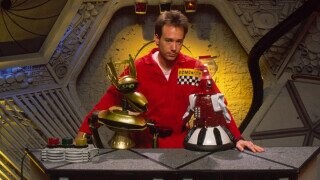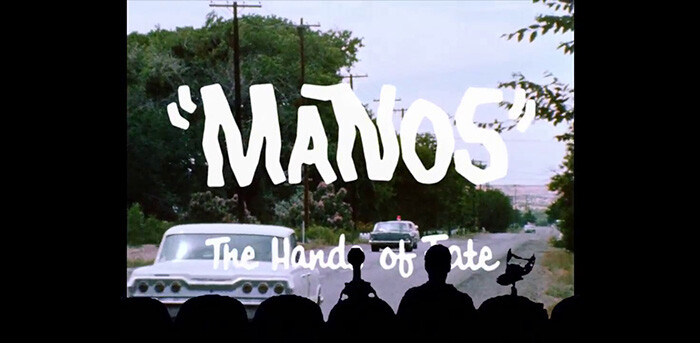Mystery Science Theater 3000: 15 Behind-The-Scenes Facts

In the not-too-distant future, you will have read this article and said out loud “This was the most interesting thing I’ve read about Mystery Science Theater 3000 in my entire life!” Joel Hodgson’s creation of this cult phenomenon Minnesota-based television show is the ultimate example of DIY comedy. Here are 15 facts you didn’t know about MST3K.
Joel Hodgson Was An Accomplished Standup Before The Show
Joel Hodgson’s stand-up routine was like a mix between Kaufman, Carrot Top, and The Amazing Jonathan. He had been featured on SNL, Letterman, and HBO several times before he created MST3K. His instinct to showcase prop building, silly inventions, and wordplay from this SNL season nine guest performance from 1984 makes it painfully apparent that MST3K was a true passion project.
Hodgson Attempted To Produce The Cheapest Show Possible

Comedy Central
Hodgson told Flavorwire, “Mystery Science Theater came from me saying, ‘What’s the cheapest possible show I could create that would still be novel and bring something new, kind of have a new angle of doing something funny?’ And so it started with me trying to think of a show that — well, it all just came together, basically, at that point when I realized it could be like hosting a movie show, and if I utilized the silhouette thing, the characters will kind of run not only through the host segments, but through the entire movie, and they’ll be, like, companions.”
The Show Was Originally On Public Broadcast
Joel knew pitching Hollywood on his show would be difficult, but because of his appearances on HBO, Letterman, and SNL, Hodgson had become Minneapolis comedy royalty. Producers at a UHF channel called KTMA agreed to run the show. Hodgson says the entire concept of the show was built as it aired at KTMA. “That’s really where we figured it all out: the theme song, the story, and even movie riffing, which wasn’t super clear when we started because I remember thinking, ‘Man, how much can we do? How much riffing can we do? At what point is it gonna become a big distraction to the audience? Can they multitask? Can they hear? Can they grasp what we’re doing?’”
The Show Had A Hotline For Audience Feedback
A phone number appeared on the screen during the first two episodes at the suggestion of producer Jim Mallon. The phone line was connected to an answering machine so people could call and say whatever they wanted. “when we checked the answering machine on Monday, it was full,” Hodgson says. “So people just reacted to it. They thought either they hated it or they liked it. Most people liked it. Obviously, when people like something, they don’t usually comment — they just ignore it”
Joel Hodgson Inadvertently Created A Bomb Threat

In 1983, Hodgson brought a fake time bomb on SNL for a joke about the audience having “three minutes left.” However, his hotel did not find it funny when they found it in his room after he had checked out. The hotel was evacuated and the bomb squad was called in to disarm the explosive. Joel had no idea he had left the prop behind until federal agents met him at the airport. Surely they must have all had a big laugh.
The Show Was Improvised Until It Left KTMA
Joel Hodgson had focused mainly on improv during his time producing the show at KTMA. He told Flavorwire, “It seemed impossible to write at that time, so we didn’t write anything. We really just went in and winged it. But at the end of KTMA, it really became clear, and especially when we cut together a sell-tape to sell to Comedy Channel. When we cut together, we cut together, like four minutes of best moments, then it dawned on me — that’s when I finally went, ‘Oh, yeah, I get it — the whole show’s gotta be like this.’ You know what I mean? It’s gotta be all riffing. And so when we went to Comedy Channel, I just said, ‘Oh, we have to start writing this because my friends are gonna see it. It’s gonna be a national show, and we have to just make it better.’”
The Show Was An Instant Hit

Comedy Central
When the show premiered on the Comedy Channel (now Comedy Central), critics and audiences applauded its originality. Entertainment Weekly even named it one of the top ten best shows of the year alongside The Simpsons and Twin Peaks.
There Are More Riffs Than You Might Realize
Hodgson said that in the first season of the show on Comedy Channel, there were “four, five hundred riffs per show.” But by the time they were in their second season, complete with an increased budget and newly found media attention, they were riffing about 700 times per episode. Now, that’s a stiff riff regiment.
Joel Doesn’t Believe The Movies Are Inherently Bad

Comedy Central
Joel explained in a recent interview that he always felt he wasn’t trying to tear down the movies. He said, “Anybody who’s savvy about the media and about movies knows, hey, a lot of these movies were made in five or six days. They weren’t designed to do anything other than get a bunch of teenagers to come to a drive-in movie, and so to treat them like they did something wrong or they don’t deserve to exist and that riffing is serving them some kind of justice isn’t it at all. Movie riffing is a way of creating new entertainment with old entertainment by collaborating with it.”
Frank Zappa Tried To Get The Writers To Develop His Script
Kevin Murphy, the voice of Tom Servo, was in his office one day when a woman called saying she was from Warner Bros and that Frank Zappa was interested in the crew developing a script. Murphy thought the entire call was a joke so he said to have Frank call him directly. Murphy, a Zappa superfan, received a call from Frank an hour later saying, “You know, when I knew that you guys were cool was when I turned on the show, and there’s Joel, and he’s wearing a clown outfit and he’s roasting a puppet over an open fire. I knew you guys were too f***ing weird for words.” The Zappa project never came to fruition as Zappa died shortly after.
Why Joel Left The Show

Comedy Central
Joel created the show with his co-producer and voice of Gypsy, Jim Mallon. After a few years, Joel says the relationship became strained, and it was evident that a potentially show-ending fight was on its way. Hodgson explained, “I felt that leaving the show would allow the show to keep going, and if I would’ve stayed and dug in and fought, it really might’ve hurt the show, and the show living on was really important to me, so I left so the show could keep going, basically.”
The Show Is Minnesota Born And Bred
As part of the deal made with the Comedy Channel Hodgson insisted the production of the show be kept in Minneapolis, leading to that warm fuzzy feeling you get while watching it, knowing the stink of Hollywood hasn’t tainted its purity.
The 3000 Was An Inside Joke

Netflix
Joel Hodgson told The Art Of The Title, “The 3000 was a joke on all the people that were attaching the year 2000 to various programs. In the late ’80s it was everywhere: ‘America 2000’ was something that George Bush Sr. was talking about a lot so I thought, ‘Wouldn’t it be cool if I name it 3000 just to confound people?’ But there was a lot of confusion about it. I never meant for the show to take place in the year 3000. That simply makes no sense! If it is the year 3000, then why are all the films and the references about the end of the 20th century? For the concept of the show, it’s just a series number like Galaxie 500 or HAL 9000. Fords aren’t from the year 500 and the HAL wasn’t from the year 9000. In hindsight, I think it’s likely that the Mads were trying to snazz up the name of the show by tacking on the 3000.”
Jonah Ray Picked His Robot Friends

Netflix
Joel Hodgson met comedian and Season 11 host Jonah Ray when he was a guest on the Nerdist podcast. Joel was immediately taken with Ray, who was already a bonified MST3K mega-fan. When season 11 finally was greenlighted, Joel handed the reigns over to Jonah, trusting him to host and pick the voices of his new robot companions. Jonah chose comedians and friends Baron Vaughn as Tom Servo and Hampton Yount as Crow.
The Inspiration Behind The Look Of The Show

Broadway Video
Joel Hodgson spoke about his DIY design style saying, “I love that homemade aesthetic — an aesthetic where you can see the seams. The example that comes to mind is an SNL sketch from the seventies when Frank Zappa was the musical guest. It was called “Night on Freak Mountain” and at a certain point they cut to a pretty crude model — which was supposed to be an exterior shot of Freak Mountain — and right away everyone in the studio audience laughed. I found it so charming, funny and real.”
For exclusive ComedyNerd content and more, subscribe to our spiffy newsletter:
Top Image: Comedy Central
